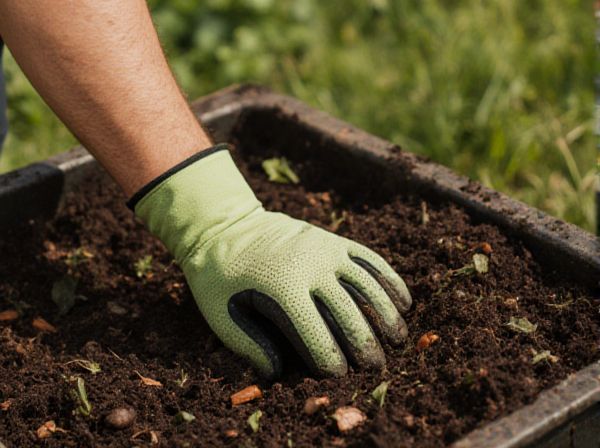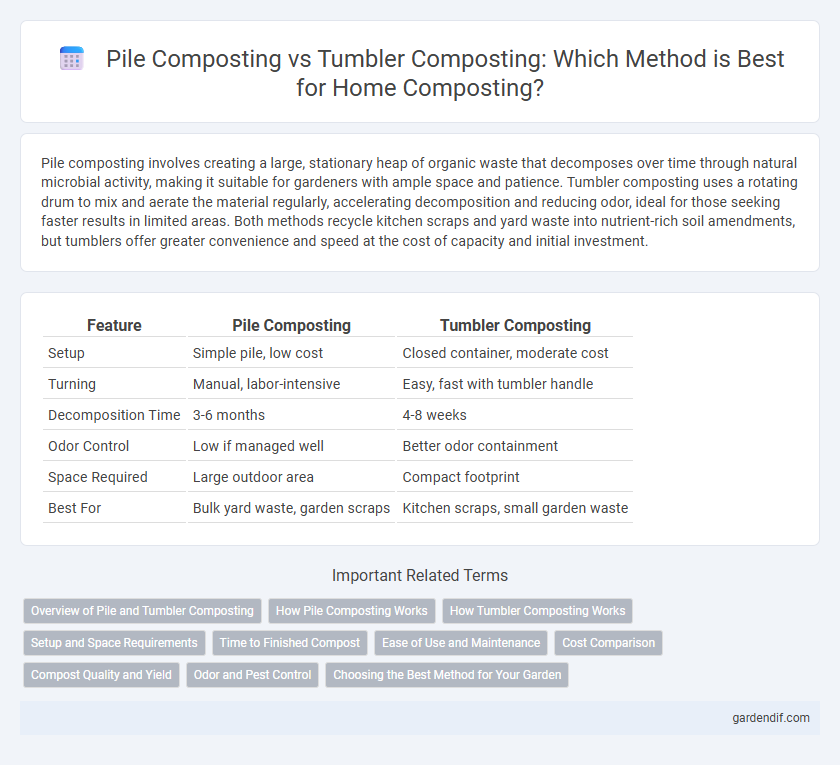
Pile Composting vs Tumbler Composting Illustration
Pile composting involves creating a large, stationary heap of organic waste that decomposes over time through natural microbial activity, making it suitable for gardeners with ample space and patience. Tumbler composting uses a rotating drum to mix and aerate the material regularly, accelerating decomposition and reducing odor, ideal for those seeking faster results in limited areas. Both methods recycle kitchen scraps and yard waste into nutrient-rich soil amendments, but tumblers offer greater convenience and speed at the cost of capacity and initial investment.
Table of Comparison
| Feature | Pile Composting | Tumbler Composting |
|---|---|---|
| Setup | Simple pile, low cost | Closed container, moderate cost |
| Turning | Manual, labor-intensive | Easy, fast with tumbler handle |
| Decomposition Time | 3-6 months | 4-8 weeks |
| Odor Control | Low if managed well | Better odor containment |
| Space Required | Large outdoor area | Compact footprint |
| Best For | Bulk yard waste, garden scraps | Kitchen scraps, small garden waste |
Overview of Pile and Tumbler Composting
Pile composting involves stacking organic waste in a heap, allowing natural microbial activity to break down materials over time, often requiring periodic turning to maintain aeration. Tumbler composting uses a sealed container mounted on a frame, which can be rotated to mix contents and speed up decomposition while minimizing odors and pest access. Both methods transform kitchen scraps and yard waste into nutrient-rich compost but differ in space requirements, maintenance effort, and processing speed.
How Pile Composting Works
Pile composting works by layering organic waste materials such as kitchen scraps, yard clippings, and leaves into a loosely stacked heap, allowing air to circulate and microorganisms to break down the matter naturally. The decomposition process relies on maintaining a proper balance of carbon-rich "browns" and nitrogen-rich "greens," along with adequate moisture and regular turning to accelerate microbial activity. This method is cost-effective and scalable, making it suitable for large quantities of compostable materials.
How Tumbler Composting Works
Tumbler composting accelerates organic waste breakdown by enclosing materials in a rotating drum that ensures consistent aeration and mixing, speeding up microbial activity. This method typically reduces composting time to a few weeks compared to traditional pile composting, which relies on manual turning and can take several months. The sealed design of a compost tumbler also helps retain heat and moisture, promoting efficient decomposition and minimizing odors.
Setup and Space Requirements
Pile composting requires a designated outdoor area typically ranging from 3 to 5 feet in width and height for effective decomposition, needing minimal initial setup beyond selecting a well-drained spot. Tumbler composting demands less space, often fitting into small yards or patios with enclosed rotating bins around 2 to 3 feet in diameter, facilitating faster decomposition through aeration. Both methods benefit from proper ventilation, but tumblers optimize space efficiency and ease of turning compared to traditional piles.
Time to Finished Compost
Pile composting typically requires 3 to 6 months to produce finished compost due to slower aeration and temperature regulation. Tumbler composting accelerates decomposition, often yielding usable compost within 2 to 4 weeks by enhancing oxygen flow and maintaining consistent heat. Choosing a method depends on desired composting speed and available effort for turning the material.
Ease of Use and Maintenance
Pile composting offers simplicity and low cost, requiring minimal setup and no special equipment, but it demands regular turning with a pitchfork to maintain aeration and moisture balance. Tumbler composting provides convenience with its enclosed design and easy turning mechanism, reducing physical effort and deterring pests, though it requires periodic cleaning to prevent buildup and ensure smooth operation. For users prioritizing low maintenance and straightforward use, tumblers present a more manageable solution, whereas pile composting suits those willing to invest manual labor for natural decomposition.
Cost Comparison
Pile composting requires minimal investment, often needing just a designated outdoor space and simple tools, making it the most cost-effective method for backyard gardeners. Tumbler composting systems involve higher upfront costs due to the purchase of specialized rotating bins, which can range from $50 to over $200 depending on capacity and features. Ongoing maintenance costs for tumblers are relatively low, but the initial expense can be a barrier compared to the virtually free setup of pile composting.
Compost Quality and Yield
Pile composting typically produces nutrient-rich, well-aerated compost with higher microbial diversity due to its larger, insulated mass, enhancing decomposition quality and volume. Tumbler composting accelerates the breakdown process through frequent aeration and mixing, resulting in faster but often smaller yields of compost with slightly less organic complexity. Both methods yield high-quality compost, but pile composting generally offers superior nutrient density and larger output.
Odor and Pest Control
Pile composting can generate stronger odors and attract pests due to slower aeration and less frequent turning, which create anaerobic conditions. Tumbler composting offers better odor control and reduces pest access by promoting aerobic decomposition through regular agitation and enclosed design. Efficient airflow in tumblers minimizes foul smells and discourages rodents and insects, enhancing overall compost hygiene.
Choosing the Best Method for Your Garden
Pile composting offers a cost-effective and simple solution for large garden spaces, relying on natural decomposition that benefits from regular turning to aerate the organic material. Tumbler composting accelerates the process through enclosed design and mechanical rotation, ideal for smaller areas and gardeners seeking odor control and faster results. Selecting the best method depends on garden size, maintenance preferences, and desired compost production speed, with pile composting suited for bulk waste and tumblers for efficient, manageable output.
Pile Composting vs Tumbler Composting Infographic

 gardendif.com
gardendif.com